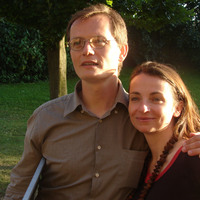
Luděk Kos
Related Authors
Ivana Boháčová
Academy of Sciences of the Czech Republic
Ladislav Varadzin
Academy of Sciences of the Czech Republic
Martin Jezek
Academy of Sciences of the Czech Republic
Marian Mazuch
Institute of Archaeology, Czech Academy of Sciences
Rudolf Procházka
Academy of Sciences of the Czech Republic
Jiří Macháček
Masaryk University
Petr Dresler
Masaryk University
InterestsView All (8)










Uploads
Papers by Luděk Kos
The contribution discusses the early medieval fortification of the outer bailey in Žatec,
Louny District. The fortification line separates a 14.5-hectare promontory from the terrace itself.
A recapitulation of new surveys carried out in various sections of the fortification in 2003,
2004 and 2008 has confirmed the existence of two basic early medieval blocks of layers, which
were perceived as two chronological phases by the original research in 1999.
The stratigraphically earlier block consists of a hewn-in berm, above which a sandy-gravel
body is built aligned with a subtle stone wall with a width of a single line of stones, without
wooden reinforcement elements except for one layer of timbers perpendicular to the course
of the fortification situated in the upper parts of the block. The block is about 1 metre high
in all sections of the line. On the surface of the block were situated the layers of the later,
1.5–1.7 metres high block and on them, wooden structures in the basis of the stone-front rampart.
This later part thus consists of a massive beam parallel with the course of the rampart,
which is secured against shifting along the slope by an upturned tree fork – a hook. Smaller
beams of the foundation grid fit tightly to the parallel beam from the inner side. The face of
the wood-and-clay rampart in the form of a dry-stone wall is situated right above the beam.
The subtle lower structure, the absence of its destruction on the berm, the unusual solution
of the base of the later block and the possible chronological proximity of the two parts lead to
the idea that they might be remnants of a single combined rampart. The dating of the Žatec
rampart (the later block has been dendrochronologically dated to the boundary between the
first and second thirds of the tenth century) offers the possibility of further discussion of the
extraordinarily interesting cultural overlap of the discovered structure.
Fig. 1:A) proved abundant evidence for human occupation, namely 227 features predominantly dating
from the Early and High Middle Ages. Earlier features (and movable finds) were also present, although in limi -
ted numbers. These were almost exclusively dating from the Roman period. These finds were complemented in
2018 when up to three sunken-floored features were discovered on the opposite bank of the Elbe River (already
in the cadastral area of Poděbrady; Fig. 1:B).
The right-bank site (Fig. 3:4) is relatively well-known in professional circles, as it is an important multiperiod
site with Neolithic, Aeneolithic, Bronze Age and especially early medieval finds. A fortification system
and a linear cemetery also allegedly date back to this period (Hellich 1923). However, finds dating from the
above-mentioned Roman period were recorded as well, represented in particular by a Roman coin (Gordian III,
238–244 AD) which was found on the bank of the Elbe River (Hellich 1916). The presented study summarizes
earlier archaeological findings and complements them with new finds. In the case of the excavation at Polabec,
these were a sunked-floored Roman period hut (Fig. 6:A), several smaller features (Fig. 6:B,C) and movable material
which ended up in medieval features as an admixture (Fig. 7). Remains of a large settlement pit (Fig. 6:D)
and two less certain post/pole built houses without a distinctive archaeological record (Fig. 6:E,F) were disco -
vered in Poděbrady (site of Na Vinicích).
The core of this study is a confrontation of this state of knowledge and natural-scientific (geological and geomorphological)
data which framed and conditioned the emergence of human occupation on this site. The site
of Polabec is namely situated in a Holocene floodplain and this fact influences all attempts at interpretation of
the finds.
Three levels of the floodplain have been identified on the middle course of the Elbe River – the higher
floodplain level, the lower floodplain level and the current floodplain (Růžičková – Zeman 1994a), whereas this
arrangement has already been observed on a number of sites in the Elbe region. A Pleistocene terrace framing
the Holocene floodplain was convincingly documented on the left bank in the analyzed area (Fig. 2:5) whose
surface lay approx. 188 m above sea level. In the same way, it is also possible to identify the current floodplain
at an altitude of ca. 186 m above sea level (Fig. 2:2). A convincing terrace step (Fig. 2:E–F) which we interpret as
one of the above mentioned floodplain levels, can be seen on the eastern side of one of the test pits excavated
during the 2012/2013 season.
In the area of the village of Polabec, elevation of Pre-quaternary chalk bedrock was identified through a
series of bore holes (Matula – Tomášek 2008; 2011) which in its maximum extent reaches the water surface of the
present-day Elbe River. This bedrock can be found at the depth of 3.7 m on the site, which is a rather low value
with regard to the fact that the surface of the floodplain terrace is situated at an altitude of 187 m above sea level
and the usual water surface of the Elbe is 184 m above sea level. Bore holes along the edge of the current
floodplain confirm the existence of a firm, stony riverbed in the place where a river crossing (a ford) connecting
Polabec and Poděbrady was possibly located. In addition, the current floodplain is relatively narrow in this
area (max. 300 m) – which is diametrically different from the expanding floodplain to the east of Polabec. On
the basis of the presented archaeological findings, we are inclined to agree with the conclusion drawn by J.
Hellich, who anticipated the existence and location of the Poděbrady ford there not only in the Early Middle
Ages, but as early as the Roman period.
The contribution discusses the early medieval fortification of the outer bailey in Žatec,
Louny District. The fortification line separates a 14.5-hectare promontory from the terrace itself.
A recapitulation of new surveys carried out in various sections of the fortification in 2003,
2004 and 2008 has confirmed the existence of two basic early medieval blocks of layers, which
were perceived as two chronological phases by the original research in 1999.
The stratigraphically earlier block consists of a hewn-in berm, above which a sandy-gravel
body is built aligned with a subtle stone wall with a width of a single line of stones, without
wooden reinforcement elements except for one layer of timbers perpendicular to the course
of the fortification situated in the upper parts of the block. The block is about 1 metre high
in all sections of the line. On the surface of the block were situated the layers of the later,
1.5–1.7 metres high block and on them, wooden structures in the basis of the stone-front rampart.
This later part thus consists of a massive beam parallel with the course of the rampart,
which is secured against shifting along the slope by an upturned tree fork – a hook. Smaller
beams of the foundation grid fit tightly to the parallel beam from the inner side. The face of
the wood-and-clay rampart in the form of a dry-stone wall is situated right above the beam.
The subtle lower structure, the absence of its destruction on the berm, the unusual solution
of the base of the later block and the possible chronological proximity of the two parts lead to
the idea that they might be remnants of a single combined rampart. The dating of the Žatec
rampart (the later block has been dendrochronologically dated to the boundary between the
first and second thirds of the tenth century) offers the possibility of further discussion of the
extraordinarily interesting cultural overlap of the discovered structure.
Fig. 1:A) proved abundant evidence for human occupation, namely 227 features predominantly dating
from the Early and High Middle Ages. Earlier features (and movable finds) were also present, although in limi -
ted numbers. These were almost exclusively dating from the Roman period. These finds were complemented in
2018 when up to three sunken-floored features were discovered on the opposite bank of the Elbe River (already
in the cadastral area of Poděbrady; Fig. 1:B).
The right-bank site (Fig. 3:4) is relatively well-known in professional circles, as it is an important multiperiod
site with Neolithic, Aeneolithic, Bronze Age and especially early medieval finds. A fortification system
and a linear cemetery also allegedly date back to this period (Hellich 1923). However, finds dating from the
above-mentioned Roman period were recorded as well, represented in particular by a Roman coin (Gordian III,
238–244 AD) which was found on the bank of the Elbe River (Hellich 1916). The presented study summarizes
earlier archaeological findings and complements them with new finds. In the case of the excavation at Polabec,
these were a sunked-floored Roman period hut (Fig. 6:A), several smaller features (Fig. 6:B,C) and movable material
which ended up in medieval features as an admixture (Fig. 7). Remains of a large settlement pit (Fig. 6:D)
and two less certain post/pole built houses without a distinctive archaeological record (Fig. 6:E,F) were disco -
vered in Poděbrady (site of Na Vinicích).
The core of this study is a confrontation of this state of knowledge and natural-scientific (geological and geomorphological)
data which framed and conditioned the emergence of human occupation on this site. The site
of Polabec is namely situated in a Holocene floodplain and this fact influences all attempts at interpretation of
the finds.
Three levels of the floodplain have been identified on the middle course of the Elbe River – the higher
floodplain level, the lower floodplain level and the current floodplain (Růžičková – Zeman 1994a), whereas this
arrangement has already been observed on a number of sites in the Elbe region. A Pleistocene terrace framing
the Holocene floodplain was convincingly documented on the left bank in the analyzed area (Fig. 2:5) whose
surface lay approx. 188 m above sea level. In the same way, it is also possible to identify the current floodplain
at an altitude of ca. 186 m above sea level (Fig. 2:2). A convincing terrace step (Fig. 2:E–F) which we interpret as
one of the above mentioned floodplain levels, can be seen on the eastern side of one of the test pits excavated
during the 2012/2013 season.
In the area of the village of Polabec, elevation of Pre-quaternary chalk bedrock was identified through a
series of bore holes (Matula – Tomášek 2008; 2011) which in its maximum extent reaches the water surface of the
present-day Elbe River. This bedrock can be found at the depth of 3.7 m on the site, which is a rather low value
with regard to the fact that the surface of the floodplain terrace is situated at an altitude of 187 m above sea level
and the usual water surface of the Elbe is 184 m above sea level. Bore holes along the edge of the current
floodplain confirm the existence of a firm, stony riverbed in the place where a river crossing (a ford) connecting
Polabec and Poděbrady was possibly located. In addition, the current floodplain is relatively narrow in this
area (max. 300 m) – which is diametrically different from the expanding floodplain to the east of Polabec. On
the basis of the presented archaeological findings, we are inclined to agree with the conclusion drawn by J.
Hellich, who anticipated the existence and location of the Poděbrady ford there not only in the Early Middle
Ages, but as early as the Roman period.